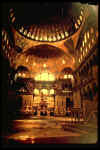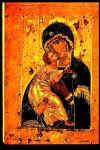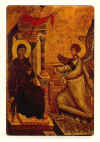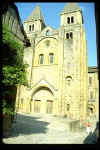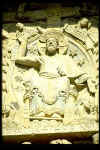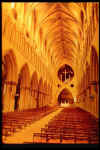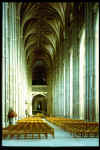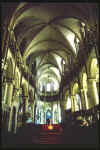MAJOR EVENTS: 500-1500
Note the links for some of these events. Try some
of them out as you try to understand the themes outlined in the notes
above.
527-565 Emperor Justinian
(The Justinian Age) re-conquers Italy and North Africa; 529 he issues the
Justinian Code of Roman law, a revision of Theodosius' Code.
540 Benedict
writes Monastic Rule
563 Columba starts Celtic Christian mission community
on Iona
590-604 Gregory I (the Great) Bishop
of Rome
597 Augustine, sent by Gregory I, converts Ethelbert,
king
of Kent (England), beginning conversion of Saxon England
622 Muhammad’s Hegira
(flight to Medina), birth or Islam
638-56 Arabs (Islam) conquer
Palestine, Iraq, Syria, Egypt
664 Celtic and Roman churches joined at Council of
Whitby in England
698 Lindisfarne Gospels
711-16 Arabs (Islam) conquer
Spain
719-754 Boniface's mission to Germans
726-843 Iconoclast Controversy in Eastern Church
732 BATTLE OF
TOURS, Arabs
driven back from France by Charles Martel
737 2nd Council of Nicea
settles Icon
controversy; resistance continues to 843. The council's position
followed John
of Damascus' Defense or Icons written about 730.
800 Charlemagne
crowned Holy Roman Emperor
861
East-West conflict over Photius
862
Cyril and Methodius begin mission to
the Slavs, expanding Greek Christianity [Eastern Orthodoxy] into eastern
Europe.
909 Monastery of Cluny founded, beginning a center for
reform
988 Conversion of Vladimir of
Kiev, beginning conversion of
Russia and extending Greek Christianity [Eastern Orthodox] into
north eastern Europe.
1054 "The Great Schism" between Rome and
Constantinople, splitting Eastern [Greek] and Western [Latin] Christianity
1059
- 1122 Investiture
Controversy: Begins in 1059 with Pope Nicholas II
condemning the custom of emperors and other secular rulers investing
bishops and abbots with their symbols of office, a practice linked to lay
patronage to key church posts.
1066
William the Conqueror and the Norman Conquest of England
1075
Pope Gregory VII prohibits all lay investiture for Church offices.
1077
Emperor Henry IV submits to Pope over Investiture
1093-1109 Anselm, Archbishop of Canterbury
1095 First Crusade begins
1105 England and Papacy compromise
over Investiture
1107 France and Papacy compromise on Investiture
1115
Bernard founds monastery at Clairvaux
1122 Concordat of
Worms ends Investiture Controversy
1141 Hildegard of Bingen
begins writing
1141 Abelard's teaching condemned
1150 Universities of
Oxford and Paris begin
1150 Mystery plays flourish
1170 Thomas
Becket, Archbishop
of Canterbury, murdered in the cathedral; Sacred
Site note
1173 Waldensian
movement begins, eventually leading to a "heretical"
movement.
1208 Francis of Assisi
renounces wealth
1215 Magna Carta
1215 Pope Innocent III
calls 4th Lateran Council
1220
Dominic establishes
Order of Preachers
1232
Pope Gregory
IX appoints "Inquisitors"
1272
Thomas Acquinas's Summa
Theologica
1302 Pope Boniface
VIII in Unam Sanctam proclaims Papal supremacy
1309
Papacy's "Babylonian" exile to Avignon in France begins a
long decline in the power of the Papacy and the health of the Western
Church. Read
a presentation about the conflict between Boniface VIII and King Philip of
France and its consequences by Dr. Ellis L. Knox Boise State University
1321
Dante's Divine Comedy
1348
Black Death begins
1370 Catherine of
Siena's Dialogue
(on her ecstatic experiences)
1371
Julian of Norwich's Showings
of Divine Love
1378 Great
Papal Schism begins [See 1309 above]
1380 John
Wyclif works on translation of the Bible
into English
1414 Council of
Constance
1415 Jan Hus burned at the stake for heresy
1431
Joan of Arc burned at the stake
1453
Constantinople falls to the Turks; end of the Eastern Roman Empire
1456
Gutenberg Bible and the cultural revolution of print
1476
Chaucer's Canterbury Tales
1479
Spanish
Inquisition established
1492 Columbus's
First
Voyage
1497 Savonarola excommunicated

